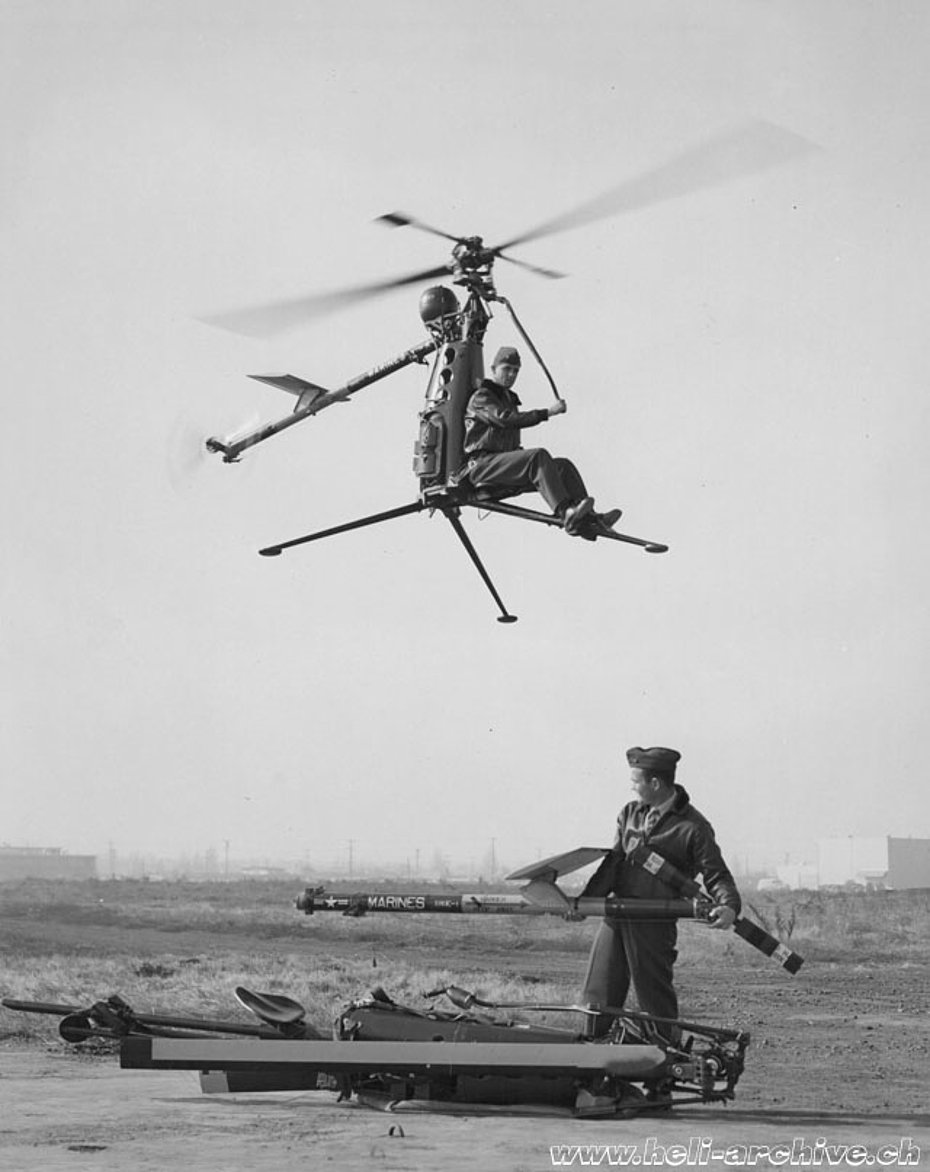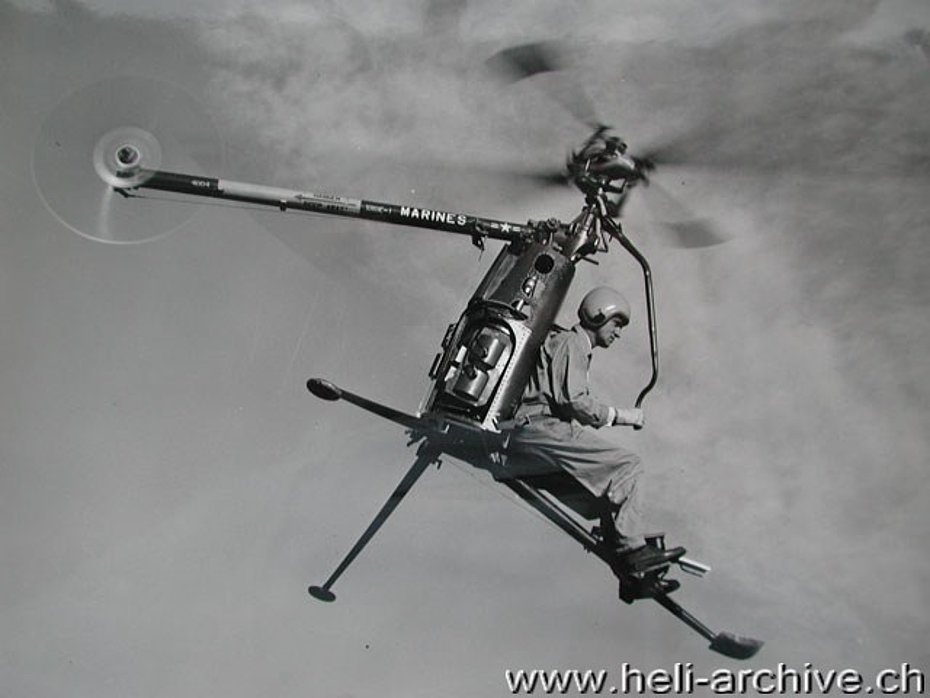Hiller XROE-1 Rotorcycle - History and technical description
Some historical notes
After the Second World War numerous american engineers started the development of the so called "pocket helicopter".
Among the first visionaries there was Horace T. Pentecost who founded Hoppi-Copter. His first model, donated to the National Air and Space Museum in 1951 (now on loan to the Pima Air and Space Museum) was quite radical and consisted of a small 20 horsepower motor powering two counter-rotating sets of rotor blades, strapped to the back of the pilot. The greatest weakness of the design was the use of the pilot’s legs as landing gear. This was, quite correctly, seen as ridiculously hazardous and the idea was quickly abandoned.
Some years later the Armed Forces, who were much interested in pocket helicopters too, launched a request of proposals for a small foldable helicopter which could be used for observation, liason, wire laying, air drop, light re-supply, messenger missions, self-rescue, escape and invasion. Thirty firms submitted their proposals.
Work on the new helicopter began at Hiller late in 1954. After a preliminary study Hiller’s technicians decided to realize a helicopter of conventional design (main and tail rotor).
Although not literally a “strap on back” rotorcycle, the model proposed by Hiller came close to this idea, since the pilot sits on what appears to be a bicycle seat, with the engine just behind his back.
In choosing a power plant for the XROE-1 weight, size, power and availability were the primary considerations.
It was on this basis that the Nelson H-59 built by Barmotive Products Inc. San Leandro was selected.
This 0.975 litre two-stroke cycle engine, later replaced with a more powerful version, had a maximum continuous power of 29.8/40 kW/cv at 4'000 rpm.
The need for complete foldability of the Rotorcycle became a major and unique problem in its overall design, which consequently resulted in some compromises. The final design permitted all parts to be folded without disconnection except for the entire tail boom assembly. However the removal of the latter was not a problem.
The unassembled helicopter could be stowed in a 0.70 x 4.25 x 0.50 m streamlined container that in case of necessity could easily be dropped by parachute from the under-wing bomb racks of tactical aircraft and then assembled in the field without special tools.
Hiller also built a special transportation carriage which was also used to rotate the helicpter into a vertical position the helicopter.
Depending on the ability of the pilot the entire aircraft could be held together by quick release “pins” and may be assembled by one person in about 10-15 minutes. Once assembly was completed the Nelson H-59 could be started with a lawn mower-type pull cord. Shortly after the helicopter was ready to take to the air.
Hiller constructed a flight test prototype along with a non-flying structural model. The prototype used for test flight was first flown in November 1956 with test pilot Richard “Dick” L. Peck at the controls. Almost simultaneously the international press started to release general information concerning the small helicopter. Some months later the US Navy officially unveiled the one-man helicopter which completed the flight tests in July 1957.
After the initial evaluations some changes were introduced. The Nelson H-59 engine, for example, was replaced with the more powerfull 32-33.5/43-45 kW/hp H-63 version.
Althoug originally built to meet the US Navy requirements, the helicopter was granted a CAA experimental certificate of airworthiness on January 24, 1958.
Hiller in fact also intended to sell the "air scooter", as it was frequently advertised, to civil customers to accomplish such missions as aerial observation (police, customs, forestry services, power lines, pipelines) postal or medical services in remote areas.
For this reason during 1958 one of the Rotorcycle was used in Europe as a demonstrator for potential foreign sales. Test-pilot Dick Peck performed flight demonstrations in Italy, Switzerland, France, Germany, England and Holland.
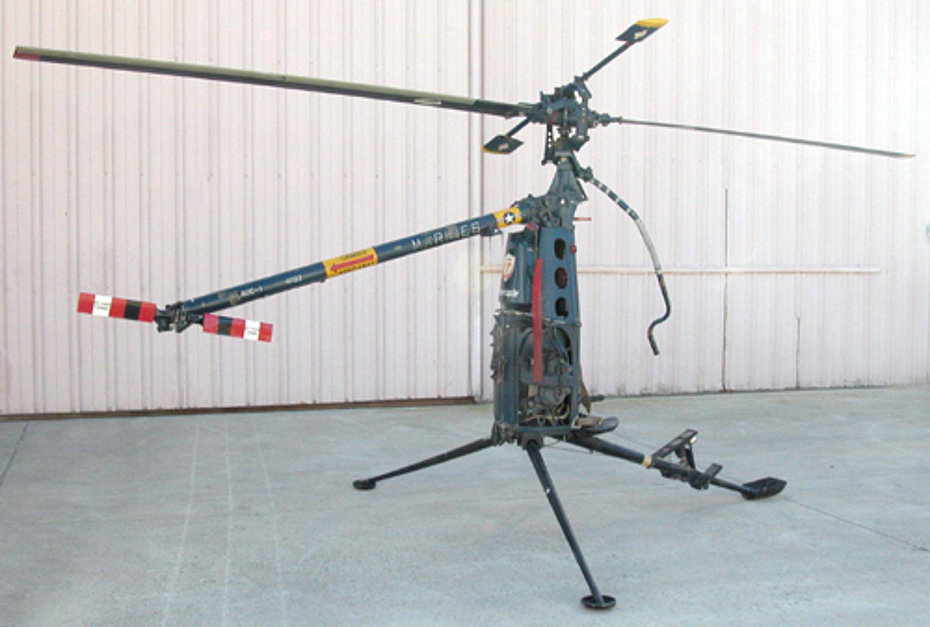
The production under licence
Because its manufacturing capability was dedicated to the production and development of other aircraft, Hiller could not afford to produce the small one-seater. For this reasons British manufacturer, Saunders-Roe Ltd based in Eastleight, built the five Marine Corps Rotorcycles under license along with an additional five aircraft for the European market.
The first five, designated YROE-1 were completed by Spring 1960 and were sent to the United States for evaluation. The further five designated Model 1033 were completed by December 1961 and used for demonstration and evaluation by European military agencies and Helicop-Air, Hiller’s European Paris based dealer.
Contrary to the expectations the pocket helicopter never entered military service. Among the reasons were the aircraft’s controls sensivity, limited performance and payload, and its vulnerability.
Even without these negative points, the advent of turbine-powered helicopters in the late 1950s and improved search and rescue techniques, made the Rotorcycle's capability redundant and resulted in the cancellation of the program.
However from a technical point of view it was certainly a success, and along with contemporaneous models such as for example the XRON-1 Rotorcycle, Rotor-Craft RH-1 Pinwheel, Goodyear GA-400R Gizmo or the Bensen B-9 Little Zipster it continues to inspire other models, especially among the home-built community.
Over the years several inventors have attempted to imitate the Rotorcycle as a sport aircraft, but the same problems which were encountered during the XROE-1's development, have kept the concept from becoming popular.
Nowadays the few Rotorclycle manufactured are almost all preserved in museums, with at least one in private hands and according available information still flying, reportedly equippped with another engine.
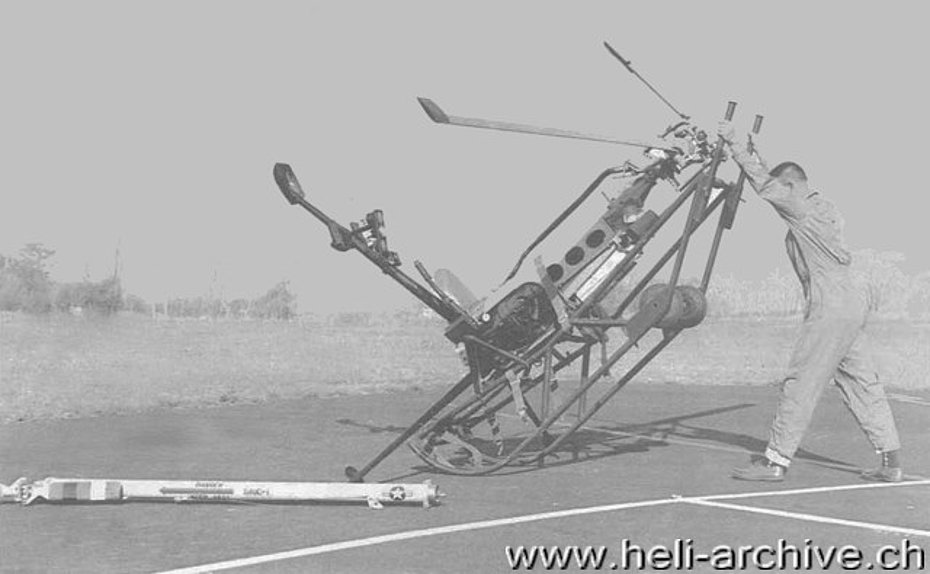
Technical description
The Hiller XROE-1 Rotorcycle is a one-seater helicopter of standard configuration. As mentioned earlier its main characteristic is the fact that it was designed to be collapsed into a container for easy transportation or parachute drop and quick assembly.
The entire aircraft is held together by 13 quick release ”pins” and may be assembled by one person in about 10-15 minutes. It is however necessary to follow a precise procedure.
The first prototype built by Hiller was slightly different from its successors. The original fuel tank of cylindrical shape for example was relocated and adapded. At the beginning the helicopter was fitted with an horizontal stabilyzer but this was later removed.
The basic structure consists of a semi-monocoque pylon, enclosing the engine, the fuel tank, a tapered tripod-type landing gear and a simple tubular tail boom.
Shoulder-harnessed the pilot sits on a completely exposed fiberglass saddle seat (adjustable for back pack).
If the pilot weighed less than 81.5 kg it was necessary to add a ballast to the front skid shoe to maintain C.G. within limits.
Hiller Rotormatic Control
The XROE-1 is fitted with a the classical Hiller Rotormatic Control System which consists of two small airfoil shapes located above the main rotor. This system functions as an aerodynamic servorotor controlling the cyclic pitch of the main rotor blades. The advantages of this system include very low cyclic feedback loads at the cyclic stick. Moreover this solution was chosen to avoid the complicated linkages which would otherwise be involved with a floor-type installation. This was even more essential in view of the folding features of the Rotorcycle. A reversing link in the cyclic control system maintains conventional helicopter control movements: if the stick is displaced forward the helicopter move forward. Otherwise, the controls are similar to those of other helicopters.
The trasmission, a Hiller design, is driven through a centrifugal clutch that automatically gives a smooth engagement at approximately 1’800 rpm. It reduces engine shaft speed (4’000 rpm) to rotor rpm (540 rpm).
The tail rotor, oil pump and tachometer drives are taken off at the first stage gear which reduces the 4’000 rpm to 1’625 rpm. The tail rotor, which rotates at 3’250 rpm, is driven from the tail rotor gear box which has a speed-up ratio of 2:1. A splinted joint, which facilitates removal of the tail boom assembly, connects the main transmission to the tail rotor drive shaft. The latter is completely enclosed in the tail boom to prevent damage in handling. A disk brake at the driven end of the trasmission stops rapidly the main and tail rotors which were of conventional all-metal design.
The 9.5 litres mixed fuel (one part of oil to eight part of gasoline) tank is mounted above and behind the engine and function as a gravity feed system.
The small instrument panel is mounted on the frontal legs of the landing gear. The panel of the XROE-1 prototype included following instruments: rotor/engine tachometer, airspeed indicator, cylinder head temperature gauge and voltmeter.
The Nelson H-63B
As mentioned earlier the Hiller XROE-1 was originally powered by a Nelson H-59 engine usually used for powered gliders. It was a horizontally opposed, four cylinder, two-stroke cycle, single-ignition air cooled engine having a rated power of 29.8/40 kW/hp at 4’000 rpm. It was then replaced with the high performance H-63B version, 1.030 litres, with a rated power of 32/33.5-43/45 kW/hp at 4'000 g/min. With this new engine the flying performance were marginally improved. This version utilized a light battery-powered starter.
The H-63B complete of exhaust stacks, carburator, starter and a 12V battery weights only 26 kg. At full power the hourly fuel consumption was about 17-18 litres. The flight endurance was about 45 min, corresponding to a range of about 60 km.
Performance
The Rotorcycle flight performance under International Standard Atmosphere (ISA) conditions are reported in the following table (engine Nelson H-63B):
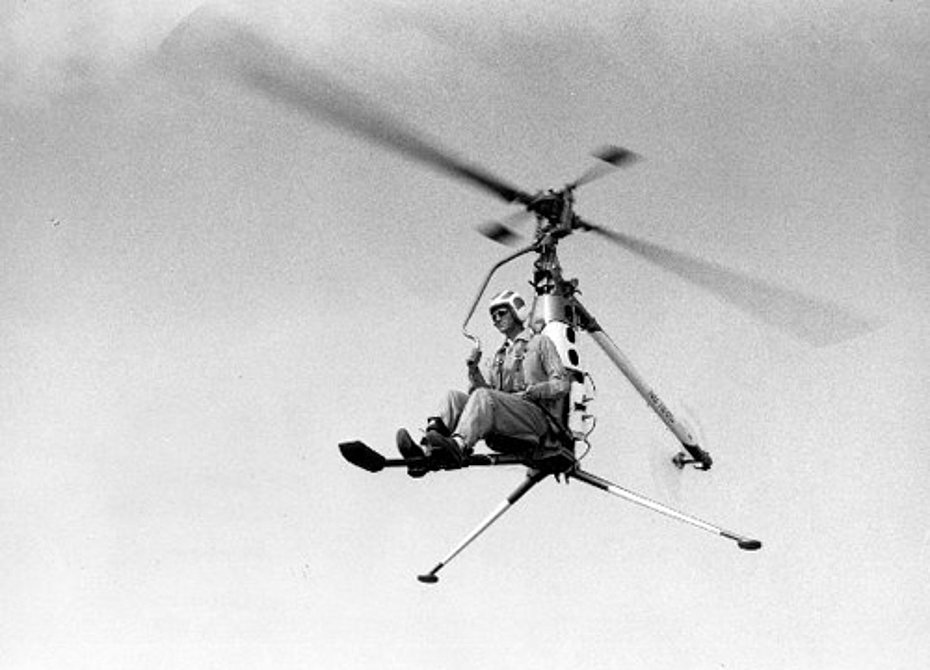
The Rotorcycle in flight
When the XROE-1 was presented to the public, Hiller claimed that it was so stable and simple to operate that a layman without flying experience would require about eight hours of dual time and two hours of solo time in a standard training helicopter before he could safely fly and execute normal maneuvres. An extension course was however recommended to prepare adequately the pilot for all situations which might be encountered during normal helicopter operations.
It seems however that test-pilot Dick Peck once confided that the helicopter was quite sensitive on the controls.
The most serious problem that haunted the Rotorcycle, and probably most of the other lightweight vertical takeoff projects of the 1950s with open cockpit, was the lack of an adequate horizon reference when flying out of ground effect. Unlike larger aircraft, the Rotorcycle did not have any protruding structures that could be visually aligned with the horizon, which made an inadvertent loss of control more likely.
Optional equipment
Apparently no optional equipment was developed for the Rotorcycle. However a mini brochure shows some designs of the helicopter transporting a small pack or wire drum (and other light cargo) attached to or slung directly below the pilot’s seat, and the helicopter fitted with a float gear.
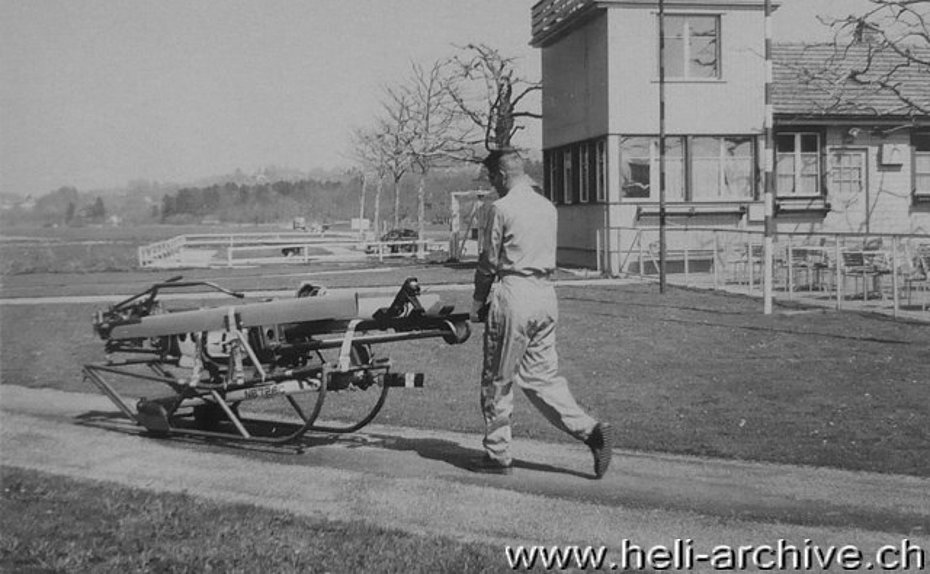
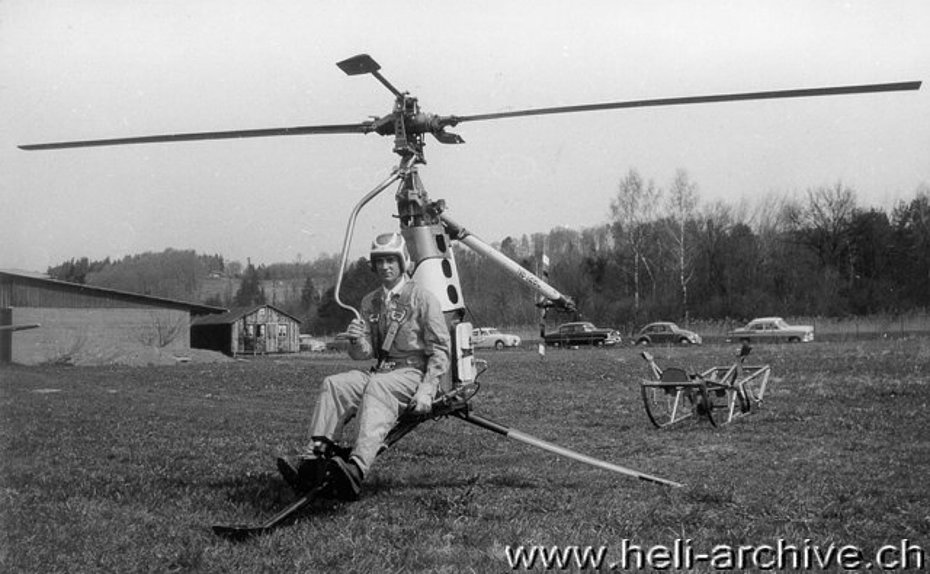
The Rotorcycle in Switzerland
The Rotorcycle arrived in Switzerland from Italy on board of a Mercedes minibus. In the latter country it was presented during the 36th annual fair organized in Milan between 12 and 27 April 1958.
The Swiss aviation company Air Import of Lucerne, which was at that time one of Hiller’s European commercial partners, took advantage of the presence in Europe of the small one seater to present it to potential customers. The first official presentation was organized in Belp/BE on April 24, 1958. The helicopter was transported completely folded on its transportation carriage and then unfolded in front of the invited group.
In about three minutes test-pilot Richard L. Peck and a mechanic assembled the one seater. A the same time the onlookers received a series of technical indications and were informed about the possible uses of the helicopter. Then the pilot started up the engine and performed a flight demonstration.
A similar flight demo was repeated at Zürich airport on April 26. On that occasion a team of the Swiss newsreel filmed the helicopter and produced the news footage nr. 818.
It is very likely that these two presentations were the only ones made in Switzerland.
References
Journal AAHS/Fall 1994 article of Kent A. Mitchell
Hiller XROE-1 Rotorcycle by Loren Raglin, Hiller Helicopters - AHS Newsletter Jan. 1958
Hiller YROE-1 Rotorcycle flight manual, Jan. 1960
Interesting links
Have a look to this British Pathé video
Video
HAB 12/2011


